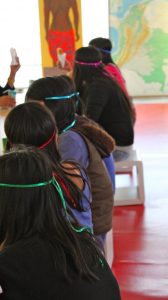By Andrée Salom, MPS, ATR | February 24, 2016 | About Art Therapy | Events | International
Across American museums, art therapy programs have been developed for individuals with disabilities, addictions, physical and psychological challenges, as well as for populations receiving disaster relief, and recovering from trauma (Peacock, 2012). Through these art therapy-museum collaborations, populations of all ages have benefited from engaging with issues such as self-concept, tolerance, inclusion, empathy and emotional expression (ibid). Practicum placements have been developed, where art therapy students and museum curators collaborate to serve community members (Treadon, 2016). Both art therapy and museums have been steadily expanding to include social action incentives, allowing an innovative integration between health and culture.

Image courtesy of photographer Angela V. Lizarralde
Art therapy-museum projects place value on subjective experiences; personal interpretations are welcome, as are diverse cultural perspectives. Such characteristics have facilitated the implementation of art therapy museum projects in Colombia, given the challenging social needs and the myriad of subcultures in the country. “Sharing Stories with Images and Art Materials” was an art therapy program conducted at the Gold Museum in Bogotá, Colombia, conceived for indigenous Colombian women of Wounaan and Guambiano ethnicities who had been internally displaced by violence within the country (Salom, 2015). The women who participated were expert artisans with deeply rooted creative traditions. Unprompted by the facilitators, the content of the women’s art products in all instances referenced their heritages (p. 56). Through photography, sculpture, mural, and traditional weaving techniques, participants represented their particular motherlands. “During the art therapy sessions at the museum the women related to the host culture [a distinct culture within their own Country] … precisely by presenting, referencing and being rooted in their culture of origin” (p. 57). Inevitably, participants developed new art forms through the contact with diverse materials. The artistic outcomes revealed a parallel between museums, art therapy, and the object relations construct of potential space (abstract).
In an earlier art therapy-museum project (2009) conducted at the Museo Arqueológico Casa del Marqués de San Jorge, the archaeological museum in Bogotá, two different populations attended separate sessions: A group of older adults who lived together at a community house, and a group of adults with self-identified objectives related to their particular life stages. Through the program, the museum was regarded as playing the role of co-leader, group member, representation of self, or as a microcosm of an individual’s environment. (Salom, 2011). Logistical considerations (timelines, space, artifact, etc.) helped shape the roles as indicated by the objectives of each session (p. 81). The program led to the understanding that it is helpful to think of the museum as having a specific function when planning art therapy-museum projects; these roles help address the diverse needs of each group or individual.

Image courtesy of photographer Angela V. Lizarralde.
Contemporary perceptions of art museums and art therapy as agents of social change allow for a creative synergy between the two. The particular movement of social inclusion that museums are undergoing facilitates an understanding of subjective experiences (Anderson, 2004) and, parallel to art therapy’s aperture towards social action incentives (Kaplan, 2007), can allow for public interventions. The health and cultural revenue of such collaborations are still only beginning in Colombia and around the globe. The experiences described above have provided reflections around culture, diversity and well-being. Imagine the potential for personal and social transformation through the worldwide cultural connectivity of museums.
References
Anderson, G. (Ed.). (2004). Reinventing the museum: historical and contemporary perspectives on the paradigm shift. Walnut Creek, CA: AltaMira Press.
Kaplan, F. (Ed.). (2007). Art therapy and social action. London, Philadelphia: J. Kingsley.
Peacock, K. (2012). Museum Education and Art Therapy: Exploring an Innovative Partnership. Art Therapy, 29(3), 133–137. http://doi.org/10.1080/07421656.2012.701604
Salom, A. (2011). Reinventing the setting: Art therapy in museums. The Arts in Psychotherapy, 38(2), 81–85. http://doi.org/10.1016/j.aip.2010.12.004
Salom, A. (2015). Weaving potential space and acculturation: Art therapy at the museum. Journal of Applied Arts & Health, 6(1), 47–62. http://doi.org/10.1386/jaah.6.1.47_1
Treadon, Carolyn Brown. (2016). Bringing art therapy into musuems. In D. Gussak & M. L. Rosal (Eds.), The Wiley handbook of art therapy (pp. 487–497).
